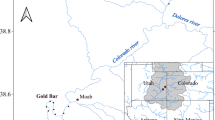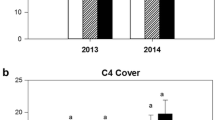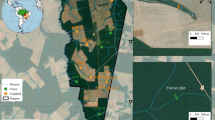Abstract
Invasive species are a major cause of biodiversity loss worldwide, but their impact on communities and the mechanisms driving those impacts are varied and not well understood. This study employs functional diversity metrics and guilds—suites of species with similar traits—to assess the influence of an invasive tree (Tamarix spp.) on riparian plant communities in the southwestern United States. We asked: (1) What traits define riparian plant guilds in this system? (2) How do the abundances of guilds vary along gradients of Tamarix cover and abiotic conditions? (3) How does the functional diversity of the plant community respond to the gradients of Tamarix cover and abiotic conditions? We found nine distinct guilds primarily defined by reproductive strategy, as well as growth form, height, seed weight, specific leaf area, drought and anaerobic tolerance. Guild abundance varied along a covarying gradient of local and regional environmental factors and Tamarix cover. Guilds relying on sexual reproduction, in particular, those producing many light seeds over a long period of time were more strongly associated with drier sites and higher Tamarix cover. Tamarix itself appeared to facilitate more shade-tolerant species with higher specific leaf areas than would be expected in resource-poor environments. Additionally, we found a high degree of specialization (low functional diversity) in the wettest, most flood-prone, lowest Tamarix cover sites as well as in the driest, most stable, highest Tamarix cover sites. These guilds can be used to anticipate plant community response to restoration efforts and in selecting appropriate species for revegetation.




Similar content being viewed by others
Availability of data and material
Data are available in the Zenodo Digital Repository; https://doi.org/10.5281/zenodo.5047316
Code availability
Not applicable.
References
Aguiar FC, Bejarano MD, Nilsson C, Martins MJ (2013) FLOBASE - a riparian plant triatbase (http://www.isa.ulisboa.pt/proj/flowbase/). Centro de Estudos Florestais, Instituto Superior de Agronomia, Universidade de Lisboa, Lisboa, Portugal
Aguiar FC, Segurado P, Martins MJ, Bejarano MD, Nilsson C, Portela MM, Merritt DM, Fortin M-J (2018) The abundance and distribution of guilds of riparian woody plants change in response to land use and flow regulation. J Appl Ecol 55:2227–2240. https://doi.org/10.1111/1365-2664.13110
Alahuhta J, Erős T, Kärnä O-M, Soininen J, Wang J, Heino J (2019) Understanding environmental change through the lens of trait-based, functional, and phylogenetic biodiversity in freshwater ecosystems. Environ Rev 27:263–273. https://doi.org/10.1139/er-2018-0071
Auerbach DA, Merritt DM, Shafroth PB (2013) Tamarix, hydrology, and fluvial geomorphology. In: Sher AA, Quigley M (eds) Tamarix: a case study of ecological change in the American West. Oxford University Press, New York
Bateman HL, Merritt DM (2020) Complex riparian habitats predict reptile and amphibian diversity. Glob Ecol Conserv 22:e00957. https://doi.org/10.1016/j.gecco.2020.e00957
Bateman HL, Nagler PL, Glenn EP (2013) Plot- and landscape-level changes in climate and vegetation following defoliation of exotic salt cedar (Tamarix sp.) from the biocontrol agent Diorhabda carinulata along a stream in the Mojave Desert (USA). J Arid Environ 89:16–20. https://doi.org/10.1016/j.jaridenv.2012.09.011
Beauchamp VB, Stromberg JC (2008) Changes to herbaceous plant communities on a regulated desert river. River Res Appl 24:754–770. https://doi.org/10.1002/rra.1078
Beauchamp VB, Shafroth PB (2011) Floristic composition, beta diversity, and nestedness of reference sites for restoration of xeroriparian areas. Ecological Applications 21(2):465–476. https://doi.org/10.1890/09-1638.1
Bejarano MD, Nilsson C, Aguiar F, Moreno Mateos D (2018) Riparian plant guilds become simpler and most likely fewer following flow regulation. J Appl Ecol 55:365–376. https://doi.org/10.1111/1365-2664.12949
Biswas SR, Mallik AU (2010) Disturbance effects on species diversity and functional diversity in riparian and upland plant communities. Ecology 91:28–35. https://doi.org/10.1890/08-0887.1
Bonham CD (1989) Measurements of terrestrial vegetation. Wiley, New York
Borcard D, Gillet F, Legendre P (2011) Numerical ecology with R, use R! Springer, New York
Bourgeois B, Munoz F, Fried G, Mahaut L, Armengot L, Denelle P, Storkey J, Gaba S, Violle C (2019) What makes a weed a weed? A large-scale evaluation of arable weeds through a functional lens. Am J Bot 106:90–100. https://doi.org/10.1002/ajb2.1213
Butterfield BJ, Grams PE, Durning LE, Hazel J, Palmquist EC, Ralston BE, Sankey JB (2020) Associations between riparian plant morphological guilds and fluvial sediment dynamics along the regulated Colorado River in Grand Canyon. River Res Appl 36:410–421. https://doi.org/10.1002/rra.3589
Catford JA, Downes BJ, Gippel CJ, Vesk PA (2011) Flow regulation reduces native plant cover and facilitates exotic invasion in riparian wetlands: flow regulation drives wetland invasion. J Appl Ecol 48:432–442. https://doi.org/10.1111/j.1365-2664.2010.01945.x
Catford JA, Morris WK, Vesk PA, Gippel CJ, Downes BJ, Diez J (2014) Species and environmental characteristics point to flow regulation and drought as drivers of riparian plant invasion. Divers Distrib 20:1084–1096. https://doi.org/10.1111/ddi.12225
Clarke RK (1993) Non-parametric multivariate analyses of changes in community structure. Aust J Ecol 18:117–143
Crandall RM, Hayes CR, Ackland EN (2003) Application of the intermediate disturbance hypothesis to flooding. Community Ecol 4:225–232. https://doi.org/10.1556/ComEc.4.2003.2.9
DeLoach CJ, Lewis PA, Herr JC, Carruthers RI, Tracy JL, Johnson J (2003) Host specificity of the leaf beetle, Diorhabda elongata deserticola (Coleoptera: Chrysomelidae) from Asia, a biological control agent for saltcedars (Tamarix: Tamaricaceae) in the Western United States. USDA-ARS 34 http://digitalcommons.unl.edu/usdaarsfacpub/324
Díaz S, Lavorel S, Chapin FS, Tecco PA, Gurvich DE, Grigulis K (2007) Functional diversity - at the crossroads between ecosystem functioning and environmental Filters. In: Canadell JG, Pataki DE, Pitelka LF (eds) Terrestrial ecosystems in a changing World. Springer, Berlin, Heidelberg
Díaz S, Kattge J, Cornelissen JHC, Wright IJ, Lavorel S, Dray S, Reu B, Kleyer M, Wirth C, Colin Prentice I, Garnier E, Bönisch G, Westoby M, Poorter H, Reich PB, Moles AT, Dickie J, Gillison AN, Zanne AE, Chave J, Joseph Wright S, Sheremet’ev SN, Jactel H, Baraloto C, Cerabolini B, Pierce S, Shipley B, Kirkup D, Casanoves F, Joswig JS, Günther A, Falczuk V, Rüger N, Mahecha MD, Gorné LD (2016) The global spectrum of plant form and function. Nature 529:167–171. https://doi.org/10.1038/nature16489
Dı́az S, Cabido M (2001) Vive la différence: plant functional diversity matters to ecosystem processes. Trends Ecol Evol 16:646–655. https://doi.org/10.1016/S0169-5347(01)02283-2
Diehl RM, Merritt DM, Wilcox AC, Scott ML (2017) Applying functional traits to ecogeomorphic processes in riparian ecosystems. Bioscience 67:729–743. https://doi.org/10.1093/biosci/bix080
Drenovsky RE, Grewell BJ, D’Antonio CM, Funk JL, James JJ, Molinari N, Parker IM, Richards CL (2012) A functional trait perspective on plant invasion. Ann Bot 110:141–153. https://doi.org/10.1093/aob/mcs100
FEIS (2020) Fire Effects Information System (www.fs.fed.us/database/feis/plants/fern/polmun/all.html). U.S. Department of Agriculture, Forest Service, Rocky Mountain Research Station, Missoula Fire Sciences Laboratory (Producer)
Foxcroft LC, Pyšek P, Richardson DM, Genovesi P, MacFadyen S (2017) Plant invasion science in protected areas: progress and priorities. Biol Invasions 19:1353–1378. https://doi.org/10.1007/s10530-016-1367-z
Friedman JM, Auble GT, Shafroth PB, Scott ML, Merigliano MF, Freehling MD, Griffin ER (2005) Dominance of non-native riparian trees in western USA. Biol Invasions 7:747–751. https://doi.org/10.1007/s10530-004-5849-z
Garfin G, Jardine A, Merideth R, Black M, LeRoy S (eds) (2013) Assessment of climate change in the Southwest United States: a report prepared for the national climate assessment. Island Press, Washington, DC
Gaskin JF (2013) Genetics of Tamarix. In: Sher AA, Quigley M (eds) Tamarix: a case study of ecological change in the American West. Oxford University Press, New York
González E, Sher AA, Tabacchi E, Masip A, Poulin M (2015) Restoration of riparian vegetation: a global review of implementation and evaluation approaches in the international, peer-reviewed literature. J Environ Manage 158:85–94. https://doi.org/10.1016/j.jenvman.2015.04.033
González E, Sher AA, Anderson RM, Bay RF, Bean DW, Bissonnete GJ, Bourgeois B, Cooper DJ, Dohrenwend K, Eichhorst KD, El Waer H, Kennard DK, Harms-Weissinger R, Henry AL, Makarick LJ, Ostoja SM, Reynolds LV, Robinson WW, Shafroth PB (2017) Vegetation response to invasive Tamarix control in southwestern U.S. rivers: a collaborative study including 416 sites. Ecol Appl 27:1789–1804. https://doi.org/10.1002/eap.1566
González E, Shafroth PB, Lee SR, Reed SC, Belnap J (2020) Riparian plant communities remain stable in response to a second cycle of Tamarix biocontrol defoliation. Wetlands 40:1863–1875. https://doi.org/10.1007/s13157-020-01381-7
Gower JC (1971) A general coefficient of similarity and some of its properties. Biometrics 27:857–871
Henry AL, Gonzalez E, Robinson WW, Bourgeois B, Sher AA (2018) Spatial modeling improves understanding patterns of invasive species defoliation by a biocontrol herbivore. Biol Invasions 20:3545–3562
Hirsch H, Allsopp MH, Canavan S, Cheek M, Geerts S, Geldenhuys CJ, Harding G, Hurley BP, Jones W, Keet J-H, Klein H, Ruwanza S, van Wilgen BW, Wingfield MJ, Richardson DM (2020) Eucalyptus camaldulensis in South Africa – past, present, future. Trans Royal Soc S Afr 75:1–22. https://doi.org/10.1080/0035919X.2019.1669732
Hultine KR, Dudley T (2013) Tamarix from organism to landscape. In: Sher AA, Quigley M (eds) Tamarix: a case study of ecological change in the American West. Oxford University Press, New York
Huston M (1979) A general hypothesis of species diversity. Am Nat 113:81–101. https://doi.org/10.1086/283366
Jarnevich CS, Evangelista P, Graham J (2013) Measuring extent and projection of Tamarix distributions in North America. In: Sher AA, Quigley M. (eds) Tamarix: A Case Study of Ecological Change in the American West. Oxford University Press, New York Julve, P., 2015. Baseflor (https://www.tela-botanica.org/). Index botanique, écologique et chorologique de la flore de France https://www.tela-botanica.org/
Kattge J, Boenish G, Diaz S, Lavorel S, Prentice IC, Leadley P, Cuntz M (2020) TRY plant trait database - enhanced coverage and open access. Glob Change Biol 26:119–188. https://doi.org/10.1111/gcb.14904
Katz GL, Tuttle GM, Denslow MW, Norton AP (2020) Legacy effects of Russian olive (Elaeagnus angustifolia L.) in a riparian ecosystem three years post-removal. Wetlands 40:1897–1907. https://doi.org/10.1007/s13157-020-01385-3
Kaufman LR, Rousseeuw P (1990) Finding groups in data: an introduction to cluster analysis. John Wiley & Sons Inc, Hoboken
Keddy P (1992) Assembly and response rules: two goals for predictive community ecology. J Veg Sci 3:157–164
Laliberté E, Legendre P (2010) A distance-based framework for measuring functional diversity from multiple traits. Ecology 91:299–305. https://doi.org/10.1890/08-2244.1
Laughlin DC (2014) Applying trait-based models to achieve functional targets for theory-driven ecological restoration. Ecol Lett 17:771–784. https://doi.org/10.1111/ele.12288
Laureto LMO, Cianciaruso MV, Samia DSM (2015) Functional diversity: an overview of its history and applicability. Natureza Conservação 13:112–116. https://doi.org/10.1016/j.ncon.2015.11.001
Legendre P, Gallagher ED (2001) Ecologically meaningful transformations for ordination of species data. Oecologia 129:271–280. https://doi.org/10.1007/s004420100716
Legendre P, Legendre L (2012) Numerical ecology, 3rd edn. Elsevier, Oxford
Lozanovska I, Ferreira MT, Aguiar FC (2018) Functional diversity assessment in riparian forests – multiple approaches and trends: a review. Ecol Ind 95:781–793. https://doi.org/10.1016/j.ecolind.2018.08.039
Martínková J, Klimeš A, Puy J, Klimešová J (2020) Response of clonal versus non-clonal herbs to disturbance: different strategies revealed. Perspect Plant Ecol Evol Syst 44:125529. https://doi.org/10.1016/j.ppees.2020.125529
McCoy-Sulentic ME, Kolb TE, Merritt DM, Palmquist E, Ralston BE, Sarr DA, Shafroth PB (2017) Changes in community-level riparian plant traits over inundation gradients, Colorado River, Grand Canyon. Wetlands 37:635–646. https://doi.org/10.1007/s13157-017-0895-3
Merritt DM, Poff NLR (2010) Shifting dominance of riparian Populus and Tamarix along gradients of flow alteration in western North American rivers. Ecol Appl 20:135–152. https://doi.org/10.1890/08-2251.1
Merritt DM, Shafroth PB (2012) Edaphic, salinity, and stand structural trends in chronosequences of native and non-native dominated riparian forests along the Colorado River, USA. Biol Invasions 14:2665–2685. https://doi.org/10.1007/s10530-012-0263-4
Merritt DM, Scott ML, Poff NL, Auble GT, Lytle DA (2010) Theory, methods and tools for determining environmental flows for riparian vegetation: riparian vegetation-flow response guilds: riparian vegetation-hydrologic models. Freshw Biol 55:206–225. https://doi.org/10.1111/j.1365-2427.2009.02206.x
Mortenson SG, Weisberg PJ (2010) Does river regulation increase the dominance of invasive woody species in riparian landscapes? Glob Ecol Biogeogr 19:562–574. https://doi.org/10.1111/j.1466-8238.2010.00533.x
Nagler PL, Glenn EP, Jarnevich CS, Shafroth PB (2011) Distribution and abundance of Saltcedar and Russian olive in the Western United States. Crit Rev Plant Sci 30:508–523. https://doi.org/10.1080/07352689.2011.615689
Nagler PL, Nguyen U, Bateman HL, Jarchow CJ, Glenn EP, Waugh WJ, van Riper C (2018) Northern tamarisk beetle (Diorhabda carinulata ) and tamarisk (Tamarix spp.) interactions in the Colorado River basin. Restor Ecol 26:348–359. https://doi.org/10.1111/rec.12575
Naiman RJ, Décamps H, McClain ME (2005) Riparia: ecology, conservation, and management of streamside communities. Elsevier Academic Press, New York
Ohrtman MK, Sher AA, Lair KD (2012) Quantifying soil salinity in areas invaded by Tamarix spp. J Arid Environ 85:114–121. https://doi.org/10.1016/j.jaridenv.2012.04.011
Oksanen J, Blanchet FG, Friendly M, Kindt R, Legendre P, McGlinn PR, O’Hara RB, Simpson GL, Solymos P, Stevens MHH (2019) vegan: community ecology package (https://CRAN.R-project.org/package=vegan). R package version 2.5-6
Pakeman RJ, Quested HM (2007) Sampling plant functional traits: What proportion of the species need to be measured? Appl Veg Sci 10:91–96. https://doi.org/10.1658/1402-2001(2007)10[91:SPFTWP]2.0.CO;2
Palmquist EC, Ralston BE, Sarr D, Merritt DM, Shafroth PB, Scott JA (2017) Functional traits and ecological affinities of riparian plants along the Colorado River in Grand Canyon. West N Am Nat 77:22–30. https://doi.org/10.3398/064.077.0104
Pinheiro J, Bates D, DebRoy S, Sarkar, D (2019) nlme: Linear and nonlinear mixed effects models (https://CRAN.R-project.org/package=nlme). R Core Team
R Core Team (2020) R: A language and environment for statistical computing (https://www.R-project.org/. R Foundation for Statistical Computing, Vienna, Austria
Richardson DM, Holmes PM, Esler KJ, Galatowitsch SM, Stromberg JC, Kirkman SP, Pysek P, Hobbs RJ (2007) Riparian vegetation: degradation, alien plant invasions, and restoration prospects. Divers Distrib 13:126–139
Royal Botanic Gardens Kew (2020) Seeds Information Database (SID) (http://data.kew.org/sid/, 6 December 2020) Version 7.1
Ruwanza S, Tshililo K (2019) Short terms soil and vegetation recovery after Acacia mearnsii removal in Vhembe Biosphere Reserve, South Africa. Appl Ecol Environ Res 17:1705–1716. https://doi.org/10.15666/aeer/1702_17051716
Santos J, Al-Azzawi M, Aronson J, Flowers TJ (2016) eHALOPH a database of salt-tolerant plants: helping to put halophytes to work. Plant Cell Physiol 57:e10. https://doi.org/10.1093/pcp/pcv155
Scott JA, Merritt DM (2020) Riparian response guilds shift in response to flow alteration in montane streams of the southern Rocky Mountains. Ecosphere 11:e03252. https://doi.org/10.1002/ecs2.3253
Shafroth PB, Cleverly JR, Dudley TL, Taylor JP, van Riper C, Weeks EP, Stuart JN (2005) Control of Tamarix in the western United States: implications for water salvage, wildlife use, and riparian restoration. Environ Manage 35:231–246. https://doi.org/10.1007/s00267-004-0099-5
Sher AA (2013) Introduction to the paradox plant. In: Sher AA, Quigley M (eds) Tamarix: a case study of ecological change in the American West. Oxford University Press, New York, pp 1–18
Sher AA, El Waer H, González E, Anderson R, Henry AL, Biedron R, Yue P (2018) Native species recovery after reduction of an invasive tree by biological control with and without active removal. Ecol Eng 111:167–175. https://doi.org/10.1016/j.ecoleng.2017.11.018
Stromberg JC, Merritt DM (2015) Riparian plant guilds of ephemeral, intermittent and perennial rivers. Freshw Biol 61:1259–1275. https://doi.org/10.1111/fwb.12686
Stromberg JC, Beauchamp VB, Dixon MD, Lite SJ, Paradzick C (2007) Importance of low-flow and high-flow characteristics to restoration of riparian vegetation along rivers in arid south-western United States. Freshw Biol 52:651–679. https://doi.org/10.1111/j.1365-2427.2006.01713.x
Tela Botanica eFlora: The collaborative encyclopedia. https://www.tela-botanica.org/. Accessed Aug 2020
USDA, NRCS (2020) The PLANTS Database (http://plants.usda.gov, 6 December 2020). National Plant Data Team, Greensboro, NC 27401-4901 USA
Viers JH, Fremier AK, Hutchinson RA, Quinn JF, Thorne JH, Vaghti MG (2012) Multiscale patterns of riparian plant diversity and implications for restoration. Restor Ecol 20:160–169. https://doi.org/10.1111/j.1526-100X.2011.00787.x
Vilà M, Espinar JL, Hejda M, Hulme PE, Jarošík V, Maron JL, Pergl J, Schaffner U, Sun Y, Pyšek P (2011) Ecological impacts of invasive alien plants: a meta-analysis of their effects on species, communities and ecosystems: ecological impacts of invasive alien plants. Ecol Lett 14:702–708. https://doi.org/10.1111/j.1461-0248.2011.01628.x
Westoby M (1998) A leaf-height-seed (LHS) plant ecology strategy scheme. Plant Soil 199:213–227
Whitson TD, Burrill LC, Dewey SA, Cudney DW, Nelson BE, Lee RD, Parker R (2012) Weeds of the West, 11th edn. The Western Society of Weed Science, Jackson
Acknowledgements
We acknowledge the National Science Foundation Dynamics of Coupled Natural and Human Systems award (project number 1617463) and the University of Denver for providing A.L.H. with salary funding, and the U.S. Geological Survey Invasive Species Program that partially funded E.G. collaboration. We thank Emily Palmquist for advising on trait data collection, Lindsay Reynolds for contributing some trait data and Pat Shafroth for advising on plant traits and guild definitions. Thanks also to the authors of González et al. 2017, Ecological Applications and González et al. 2017, Biological Conservation for providing plant species and environmental data, as well as to Alex Goetz, Kayleigh Kearnan, Kyla Reiner and James Sheinbaum for assistance in trait data collection. This study complies with the current laws of the country in which it was performed.
Funding
We acknowledge the National Science Foundation Dynamics of Coupled Natural and Human Systems award (project number 1617463) and the University of Denver for providing A.L.H. with salary funding, and the U.S. Geological Survey Invasive Species Program that partially funded E.G. collaboration.
Author information
Authors and Affiliations
Contributions
ALH, EG and AAS conceived the ideas. ALH collected and analyzed the data with the advice of all authors. BB contributed to scripts for analysis. All authors discussed and interpreted the results. ALH led the writing and all authors contributed to the manuscripts revisions and intellectual content and gave approval for publication.
Corresponding author
Ethics declarations
Conflict of interest
The authors declare that they have no conflict of interest.
Additional information
Communicated by Edith B. Allen.
Supplementary Information
Below is the link to the electronic supplementary material.
Rights and permissions
About this article
Cite this article
Henry, A.L., González, E., Bourgeois, B. et al. Invasive tree cover covaries with environmental factors to explain the functional composition of riparian plant communities. Oecologia 196, 1139–1152 (2021). https://doi.org/10.1007/s00442-021-04990-z
Received:
Accepted:
Published:
Issue Date:
DOI: https://doi.org/10.1007/s00442-021-04990-z




